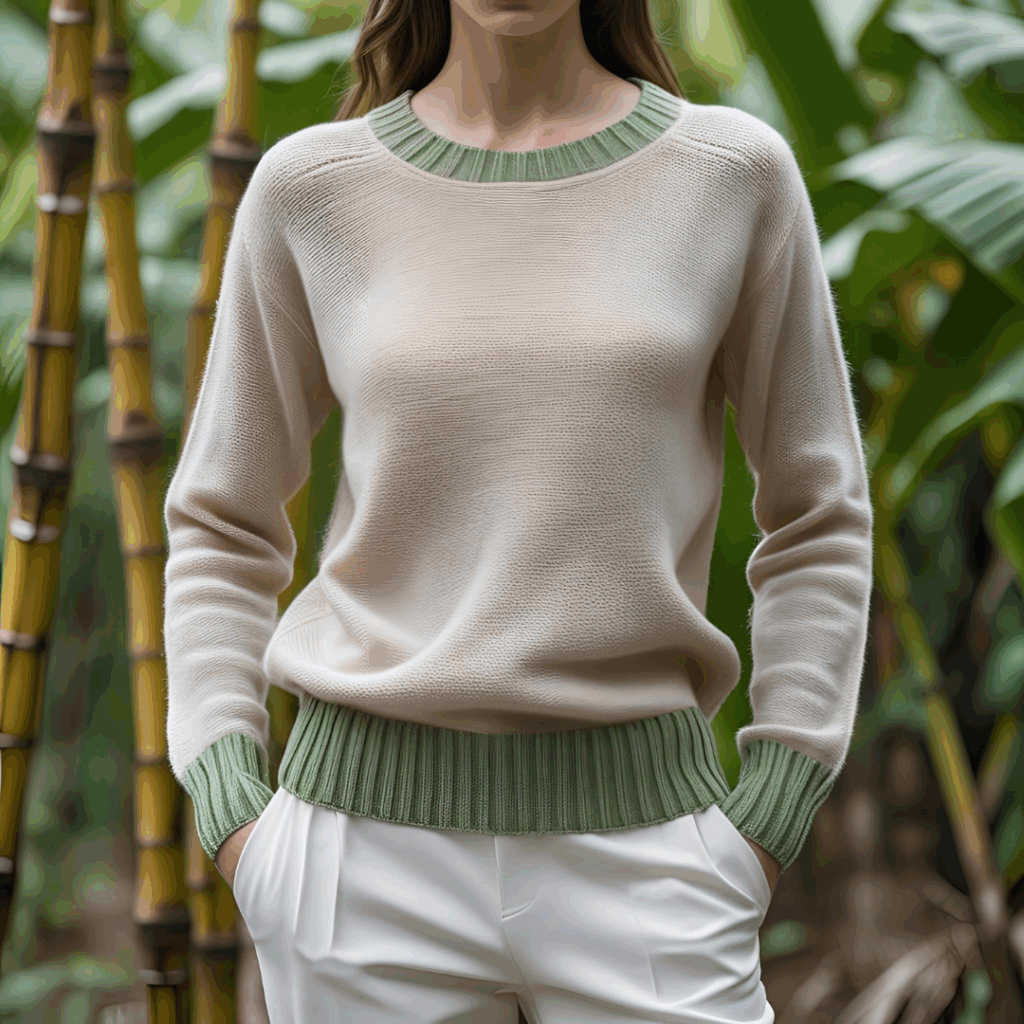The fashion industry is undergoing an urgent transformation. More and more consumers are becoming aware of where their clothes come from—especially when it comes to environmental impact and the ethics behind the materials. In this context, traditional wool—made from the hair of animals like sheep, goats, and alpacas—is increasingly being questioned. An innovative and conscious alternative has emerged: plant-based wool, produced from plant fibers such as bamboo and banana pseudostem.
But can plant-based wools truly replace animal wool in terms of comfort, durability, and quality? And what should we consider when choosing between the two?
In this complete guide, you’ll understand the key differences between traditional wool and plant-based wool, evaluating their environmental impact, animal welfare, technical performance, and innovation potential. Let’s dive into this comparison to help you make more conscious fashion choices aligned with the future.
🧵 What Is Traditional Wool?
Traditional wool is a natural fiber of animal origin, primarily obtained from sheep shearing. Other popular variations include:
- Cashmere: From Cashmere goats.
- Alpaca: From camelids native to South America.
- Merino Wool: From a specific breed of sheep known for its fine fiber.
Although valued for being breathable, thermally insulating, and biodegradable, animal wool production raises serious ethical and environmental concerns.
❌ Drawbacks of Traditional Wool:
- Animal exploitation: Even when shearing is painless, practices like mulesing (removal of skin without anesthesia) and large-scale commercial livestock farming cause animal suffering.
- High environmental impact: Large herds consume vast natural resources, emit greenhouse gases like methane (a potent contributor to global warming), and contribute to deforestation and soil degradation.
- Chemical pollution: Wool is often treated with bleach, pesticides (for parasites), and harsh detergents that contaminate water and soil.
- High water footprint: Raising sheep and processing wool require massive amounts of water.
🌱 What Is Plant-Based Wool?
Plant-based wool is an innovative textile fiber created from renewable plant sources. The most promising ones include:
- Bamboo: A lightweight, naturally antibacterial, thermoregulating, and highly breathable fiber ideal for a range of climates.
- Banana (pseudostem fiber): Strong, durable, and surprisingly soft when properly processed. The pseudostem is the trunk-like part of the banana plant, usually discarded after harvest.
These fibers undergo advanced technological processes to be spun into yarns suitable for knitting sweaters, scarves, and other items with similar softness and functionality to animal wool.


✅ Benefits of Plant-Based Wool:
- Cruelty-free: No animals are harmed or exploited in its production.
- Biodegradable: Like traditional wool, but with a significantly lower initial environmental impact.
- Hypoallergenic and antibacterial: Especially in the case of bamboo, making it ideal for sensitive skin.
- Low ecological footprint: Requires far less water, land, and energy than animal wool.
- Waste utilization: Banana pseudostems—normally discarded—are repurposed, reducing waste and adding value.
Side-by-Side Comparison: Traditional Wool vs. Plant-Based Wool
| Feature | Traditional Wool | Plant-Based Wool (Bamboo/Banana) |
|---|---|---|
| Origin | Animal | Plant-based (renewable sources) |
| Animal Welfare | Often compromised (mulesing, exploitation) | No animal exploitation |
| Sustainability | High carbon footprint, deforestation | Low carbon footprint, low water use |
| Water Consumption | High (raising sheep, wool processing) | Low (cultivation and fiber processing) |
| Allergens | Can irritate sensitive skin | Hypoallergenic (especially bamboo) |
| Durability | High, varies by wool type and care | High, with proper care; naturally strong |
| Biodegradable | Yes | Yes |
| Thermal Comfort | Excellent insulation for cold climates | Excellent breathability in mild climates |
| Innovation & Tech | Low recent evolution in sustainability | High innovation and growth in material R&D |
| Average Price | Can be expensive, depending on quality | Competitive, still evolving by brand |
Environmental Impact: Who Wins?
In this category, plant-based wool is the clear winner. Bamboo cultivation, for example, requires no pesticides, grows quickly, and uses minimal water. Banana fiber repurposes agricultural waste, preventing environmental damage and generating income for local farmers.
Animal wool, on the other hand, is intrinsically tied to the livestock industry—one of the largest contributors to greenhouse gas emissions, deforestation, and land degradation. Its environmental implications are complex and far-reaching.
Style and Versatility
Forget the notion that sustainable fashion is boring. Today, many brands are creating stylish plant-based wool pieces with great thermal comfort and a polished finish. These fabrics are light, soft, and breathable—perfect for tropical and mild climates. In colder regions, they can be layered or combined with other innovative materials for warmth without excess bulk.
👕 Brands Using Plant-Based Wool
The innovation of plant-based wool is already hitting the racks! Here are a few brands investing in these materials:
- Bamigo (Europe): Specializes in bamboo underwear and tees, with a luxurious feel and clean design.
- Green Banana Paper (Micronesia): Uses banana fibers not only for clothing, but also for wallets, bags, and handmade paper—showing the material’s versatility.
- Boody (Australia): Focused on comfortable bamboo essentials with a strong sustainability ethos.
- Malai (India): Creates circular fashion pieces from various plant fibers and agro-industrial waste.
How to Care for Plant-Based Wool
To ensure longevity and preserve the beauty of your plant-based wool garments, follow these simple care tips:
- Hand wash or use a gentle machine cycle.
- Use mild soap and cold water.
- Avoid tumble dryers: opt for air drying on a flat surface or clothesline.
- Store in a cool, dry place away from direct sunlight.
With proper care, your pieces will last for years and remain as beautiful as when new.
🧠 Which Wool Should You Choose?
If your goal is to dress with consciousness, style, and environmental responsibility, plant-based wool emerges as a powerful, ethical alternative to traditional wool. It combines innovation, animal respect, a reduced environmental impact, and still delivers the comfort and fashion we all seek.
The future of fashion is ethical, technological, and regenerative. And by choosing between animal and plant-based wool, you’re also choosing the kind of world you want to build. Your decision matters.







